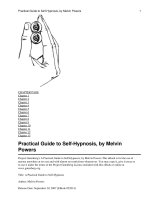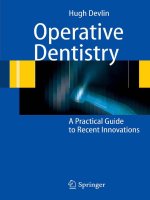Echocardiography A Practical Guide to Reporting - part 10 pptx
Bạn đang xem bản rút gọn của tài liệu. Xem và tải ngay bản đầy đủ của tài liệu tại đây (269.25 KB, 16 trang )
2. NORMAL VALUES FOR REPLACEMENT HEART VALVES
10,12
• Surprisingly few published data exist for normally functioning valves.
These tables draw on all the literature to the end of 2005.
• The short and long forms of the modified Bernoulli equation and the
classical and modified versions of the continuity equation are used
variously, and this accounts for some variation in results.
• Pressure half-time and the Hatle formula are not valid in normally
functioning mitral prostheses, and are omitted.
• Doppler results are broadly similar for valves sharing a similar design.
For simplicity, results for one design in each category are given, with
a list of other valve designs for which data exist.
• Sizing conventions vary, so it is possible that a given label size for a
valve not on the list may not be equivalent to those that are. A change
on serial studies is more revealing than a single measurement, and the
echocardiogram must be interpreted in the clinical context.
• The values (Tables A2.1–A2.3) shown are means, with standard devia-
tion in parentheses.
3. SUMMARY OF FORMULAE
3.1 Bernoulli equation
This equates potential and kinetic energy up- and downstream from a
stenosis. The modified formula is used in two forms:
short modified Bernoulli equation
∆P = 4v
2
2
long modified Bernoulli equation
∆
P = 4(v
2
2
– v
1
2
)
where ∆P is the transvalvar pressure difference, v
1
is the subvalvar veloc-
ity, and v
2
is the transvalvar velocity. The short form can be used when
the subvalvar velocity is much less than the transvalvar velocity, e.g., in
mitral stenosis or moderate or severe aortic stenosis (v
2
>3 m/s), but not
in mild aortic stenosis or for normally functioning replacement valves.
3.2 Continuity equation
This is used in two forms:
classical continuity equation
EOA = CSA ×
ᎏ
V
V
T
T
I
I
1
2
ᎏ
Echocardiography: A Practical Guide for Reporting
134
Appendices 4/5/07 12:55 pm Page 134
Appendices
135
Table A2.1 Aortic position: biological
V
max
Peak ∆P Mean ∆P EOA
(m/s) (mmHg) (mmHg) (cm
2
)
Stented porcine: Carpentier–Edwards standard as example (values similar
for Carpentier–Edwards Supra-Annular, Intact, Hancock I and II, Mosaic,
Biocor, Epic)
19 mm 43.5 (12.7) 25.6 (8.0) 0.9 (0.2)
21 mm 2.8 (0.5) 27.2 (7.6) 17.3 (6.2) 1.5 (0.3)
23 mm 2.8 (0.7) 28.9 (7.5) 16.1 (6.2) 1.7 (0.5)
25 mm 2.6 (0.6) 24.0 (7.1) 12.9 (4.6) 1.9 (0.5)
27 mm 2.5 (0.5) 22.1 (8.2) 12.1 (5.5) 2.3 (0.6)
29 mm 2.4 (0.4) 9.9 (2.9) 2.8 (0.5)
Stented bovine pericardial: Baxter Perimount as example (similar for
Mitroflow, Edwards Pericardial, Labcor-Santiago, Mitroflow)
19 mm 2.8 (0.1) 32.5 (8.5) 19.5 (5.5) 1.3 (0.2)
21 mm 2.6 (0.4) 24.9 (7.7) 13.8 (4.0) 1.3 (0.3)
23 mm 2.3 (0.5) 19.9 (7.4) 11.5 (3.9) 1.6 (0.3)
25 mm 2.0 (0.3) 16.5 (7.8) 10.7 (3.8) 1.6 (0.4)
27 mm 12.8 (5.4) 4.8 (2.2) 2.0 (0.4)
Homograft
22 mm 1.7 (0.3) 5.8 (3.2) 2.0 (0.6)
26 mm 1.4 (0.6) 6.8 (2.9) 2.4 (0.7)
Stentless
Whole root as inclusion: St Jude Toronto (similar for Prima)
21 mm 22.6 (14.5) 10.7 (7.2) 1.3 (0.6)
23 mm 16.2 (9.0) 8.2 (4.7) 1.6 (0.6)
25 mm 12.7 (8.2) 6.3 (4.1) 1.8 (0.5)
27 mm 10.1 (5.8) 5.0 (2.9) 2.0 (0.3)
29 mm 7.7 (4.4) 4.1 (2.4) 2.4 (0.6)
Cryolife–O’Brien (similar for Freestyle)
19 mm 9.0 (2.0) 1.5 (0.3)
21 mm 6.6 (2.9) 1.7 (0.4)
23 mm 6.0 (2.3) 2.3 (0.2)
25 mm 6.1 (2.6) 2.6 (0.2)
27 mm 4.0 (2.4) 2.8 (0.3)
V
max
, peak velocity; ∆P, pressure difference; EOA, effective orifice area
Appendices 4/5/07 12:55 pm Page 135
Echocardiography: A Practical Guide for Reporting
136
Table A2.2 Aortic position: Mechanical
V
max
Peak ∆P Mean ∆P EOA
(m/s) (mmHg) (mmHg) (cm
2
)
Single tilting disk
Medtronic-Hall (values similar for Bjork–Shiley Monostrut and CC,
Omnicarbon, Omniscience)
20 mm 2.9 (0.4) 34.4 (13.1) 17.1 (5.3) 1.2 (0.5)
21 mm 2.4 (0.4) 26.9 (10.5) 14.1 (5.9) 1.1 (0.2)
23 mm 2.4 (0.6) 26.9 (8.9) 13.5 (4.8) 1.4 (0.4)
25 mm 2.3 (0.5) 17.1 (7.0) 9.5 (4.3) 1.5 (0.5)
27 mm 2.1 (0.5) 18.9 (9.7) 8.7 (5.6) 1.9 (0.2)
Bileaflet mechanical
Intrannular: St Jude Standard (similar for Carbomedics Standard, Edwards
Mira, ATS, Sorin Bicarbon)
19 mm 2.9 (0.5) 35.2 (11.2) 19.0 (6.3) 1.0 (0.2)
21 mm 2.6 (0.5) 28.3 (10.0) 15.8 (5.7) 1.3 (0.3)
23 mm 2.6 (0.4) 25.3 (7.9) 13.8 (5.3) 1.6 (0.4)
25 mm 2.4 (0.5) 22.6 (7.7) 12.7 (5.1) 1.9 (0.5)
27 mm 2.2 (0.4) 19.9 (7.6) 11.2 (4.8) 2.4 (0.6)
29 mm 2.0 (0.1) 17.7 (6.4) 9.9 (2.9) 2.8 (0.6)
Intra-annular modified cuff or partially supra-annular: MCRI On-X (similar
for St Jude Regent, St Jude HP, Carbmedics Reduced Cuff, Medtronic
Advantage)
19 mm 21.3 (10.8) 11.8 (3.4) 1.5 (0.2)
21 mm 16.4 (5.9) 9.9 (3.6) 1.7 (0.4)
23 mm 15.9 (6.4) 8.6 (3.4) 1.9 (0.6)
25mm 16.5 (10.2) 6.9 (4.3) 2.4 (0.6)
Supra-annular: Carbomedics TopHat
21 mm 2.6 (0.4) 30.2 (10.9) 14.9 (5.4) 1.2 (0.3)
23 mm 2.4 (0.6) 24.2 (7.6) 12.5 (4.4) 1.4 (0.4)
25 mm 9.5 (2.9) 1.6 (0.3)
Ball and cage: Starr–Edwards
23 mm 3.4 (0.6) 32.6 (12.8) 22.0 (9.0) 1.1 (0.2)
24 mm 3.6 (0.5) 34.1 (10.3) 22.1 (7.5) 1.1 (0.3)
26 mm 3.0 (0.2) 31.8 (9.0) 19.7 (6.1)
27 mm 30.8 (6.3) 18.5 (3.7)
29 mm 29.3 (9.3) 16.3 (5.5)
V
max
, peak velocity; ∆P, pressure difference; EOA, effective orifice area
Appendices 4/5/07 12:55 pm Page 136
Appendices
137
Table A2.3 Mitral position
V
max
(m/s) Mean ∆P (mmHg)
Stented Porcine: Carpentier–Edwards (values similar for Intact, Hancock)
27 mm 6.0 (2.0)
29 mm 1.5 (0.3) 4.7 (2.0)
31 mm 1.5 (0.3) 4.5 (2.0)
33 mm 1.4 (0.2) 5.4 (4.0)
Pericardial: Ionescu–Shiley (similar for Labcor–Santiago, Hancock
Pericardial, Carpentier–Edwards Pericardial)
25 mm 1.4 (0.2) 4.9 (1.1)
27 mm 1.3 (0.2) 3.2 (0.8)
29 mm 1.4 (0.2) 3.2 (0.6)
31 mm 1.3 (0.1) 2.7 (0.4)
Single tilting disc: Bjork–Shiley Monostrut (similar for Omnicarbon)
25 mm 1.8 (0.3) 5.6 (2.3)
27 mm 1.7 (0.4) 4.5 (2.2)
29 mm 1.6 (0.3) 4.3 (1.6)
31 mm 1.7 (0.3) 4.9 (1.6)
33 mm 1.3 (0.3)
Bileaflet: Carbomedics (similar for St Jude)
25 mm 1.6 (0.2) 4.3 (0.7)
27 mm 1.6 (0.3) 3.7 (1.5)
29 mm 1.8 (0.3) 3.7 (1.3)
31 mm 1.6 (0.4) 3.3 (1.1)
33 mm 1.4 (0.3) 3.4 (1.5)
Caged ball: Starr–Edwards
28 mm 1.8 (0.2) 7.0 (2.8)
30 mm 1.8 (0.2) 7.0 (2.5)
32 mm 1.9 (0.4) 5.1 (2.5)
V
max
, peak velocity; ∆P, pressure difference
Appendices 4/5/07 12:55 pm Page 137
modified continuity equation
EOA = CSA ×
ᎏ
v
v
1
2
ᎏ
where EOA is the effective orifice area, CSA is the cross-sectional area of
the left ventricular outflow tract, and VTI
1
and VTI
2
are the subaortic and
transaortic systolic velocity time integrals. The modified form is only a
reasonable approximation in significant aortic stenosis.
3.3 Pressure half-time
The pressure half-time orifice area formula gives the effective mitral orifice
area MOA (in cm
2
)
MOA =
ᎏ
2
T
2
1/
0
2
ᎏ
where T
1/2
is the pressure half-time (in ms). This formula should only be
used in moderate or severe stenosis. It is not valid for normally function-
ing replacement valves.
3.4 Stroke volume
The stroke volume SV is given by
SV = CSA × VTI
1
where CSA is the cross-sectional area of the left ventricular outflow tract
(in cm
2
), and VTI
1
is the subaortic velocity time integral (in cm).
3.5 Shunt calculation
The stroke volume is calculated for the aortic valve as above and then for
the pulmonary valve using the diameter at the pulmonary annulus and the
velocity time integral calculated with the pulsed sample at the level of the
annulus. If the annulus cannot be imaged reliably, the diameter of the
pulmonary artery and the level for velocity recording should be taken
downstream. The shunt is then the ratio of pulmonary stroke volume to
aortic stroke volume (see also Table 11.2)
3.6 Flow
The flow is given by
Flow = CSA × VTI
1
×
ᎏ
1
S
0
E
0
T
0
ᎏ
Echocardiography: A Practical Guide for Reporting
138
Appendices 4/5/07 12:55 pm Page 138
where CSA is the cross-sectional area of the left ventricular outflow tract
(in cm
2
), VTI
1
is the subaortic velocity time integral (in cm), and SET is
the systolic ejection time (from opening to closing artefact of the aortic
signal) (in ms).
3.7 LV mass
The left ventricular mass is given by
LV mass = 1.04 × [(LVDD + IVS + PW)
3
– LVDD
3
] – 13.6
where LVD is the LV internal diameter, IVS is the thickness of the inter-
ventricular septum, and LPW is the thickness of the LV posterior wall.
This is the Devereux formula, which is widely applied although it is not
as accurate as two-dimensional methods. It also uses the Penn convention
of measurement, taking the septal and posterior wall thicknesses from
inner to inner. Using the ASE convention (i.e. leading edge to leading
edge), the simplified and modified formula is
LV mass = 0.83 × [(LVDD + IVS + PW)
3
– LVDD
3
]
3.8 Other formulae
These are either not in universal use or lack adequate validation data
3.9 Systemic vascular resistance from mitral regurgitation
and stroke distance
• Measure the peak velocity of the mitral regurgitant signal on contin-
uous wave: MR V
max
.
• Measure the stroke distance in the apical 5-chamber view: VTI
1
.
• The systemic vascular resistance is then
13
ᎏ
M
V
R
T
V
I
1
max
ᎏ
• A ratio >0.27 suggests high resistance and <0.2 suggests normal
resistance.
3.10 Mean pulmonary artery pressure from pulmonary
regurgitant signal
This could be useful if an estimate of pulmonary pressure is needed and
there is no measurable tricuspid regurgitant jet.
• Measure the peak pulmonary regurgitant velocity: PR V
max
.
Appendices
139
Appendices 4/5/07 12:55 pm Page 139
• The mean pulmonary artery pressure is 4 × PR V
max
2
, with no need
to add an estimate of right atrial pressure.
14
3.11 RV systolic function using the Tei index
15
• Record the transtricuspid flow using pulsed Doppler. Measure the
time a from the end of one signal to the start of the next.
• Record the transpulmonary flow using pulsed Doppler. Measure the
ejection time b, which is the time from the start to the end of flow.
• The Tei index is then (a – b)/b.
• The normal range for the right ventricle is 0.2–0.32.
3.12 Grading aortic stenosis from the continuous-wave signal
The ratio of peak to mean gradient has been shown to correlate well with
effective orifice area by the continuity equation in patients with both
normal and reduced LV ejection fraction
16
and could be a guide to the
need for dobutamine stress in patients with a low LV ejection fraction and
aortic stenosis of uncertain grade.
• Trace the optimum continuous wave signal to derive peak and mean
gradient.
• The ratio of the peak to mean gradient is then interpreted as shown
in Table A3.1.
3.13 LV diastolic function using flow propagation
17
• From a 4-chamber view, place the colour box over the mitral valve
and the base of the LV. Place the cursor over the inflow signal. Reduce
the velocity on the colour scale if necessary to ensure a clear aliasing
signal in the red forward flow on colour M-mode.
• Use the calliper to draw a line about 4–5 cm long along the edge of
the colour change on the early diastolic signal and calculate the slope
(V
p
).
• Divide this into the peak transmitral E-wave velocity.
• High filling pressures are suggested by a V
p
/E ratio >1.8.
Echocardiography: A Practical Guide for Reporting
140
Table A3.1 Interpretation of peak to mean gradient ratio
Ratio Grade of aortic stenosis
<1.5 Always severe
1.5–1.7 Severe stenosis possible; consider dobutamine stress
>1.7 Mild or moderate
Appendices 4/5/07 12:55 pm Page 140
4. BODY SURFACE NOMOGRAM
See Figure A4.1.
Appendices
141
Figure A4.1 Body surface nomogram. Put a straight edge against the patient’s
height and weight, and read off the body surface area on the middle column
Appendices 4/5/07 12:55 pm Page 141
REFERENCES
1. Lauer MS, Larson MG, Levy D. Gender-specific reference M-mode values in adults:
population-derived values with consideration of the impact of height. J Am Coll Cardiol
1995; 26:1039–46.
2. Devereux RB, Lutas EM, Casale PN, et al. Standardization of M-mode echocardio-
graphic left ventricular anatomic measurements. J Am Coll Cardiol 1984; 4:1222–30.
3. Nidorf SM, Picard MH, Triulzi MO, et al. New perspectives in the assessment of
cardiac chamber dimensions during development and adulthood. J Am Coll Cardiol
1992; 19:983–988.
4. Pearlman JD, Triulzi MO, King ME, Newell J, Weyman AE. Limits of normal left
ventricular dimensions in growth and development: analysis of dimensions and variance
in the two-dimensional echocardiograms of 268 normal healthy subjects. J Am Coll
Cardiol 1988; 12:1432–41.
5. Triulzi MO, Gillam LD, Gentile F. Normal adult cross-sectional echocardiographic
values: linear dimensions and chamber areas. Echocardiography 1984; 1:403–26.
6. Foale R, Nihoyannopoulos P, McKenna W, et al. Echocardiographic measurement of
the normal adult right ventricle. Br Heart J 1986; 56:33–44.
7. Zarich SW, Arbuckle BE, Cohen LR, Roberts M, Nesto RW. Diastolic abnormalities
in young asymptomatic diabetic patients assessed by pulsed Doppler echocardiography.
J Am Coll Cardiol 1988; 12:114–20.
8. Van Dam I, Fast J, de Boo T, et al. Normal diastolic filling patterns of the left ventri-
cle. Eur Heart J 1988; 9:165–71.
9. Sagie A, Benjamin EJ, Galderisi M, et al. Reference values for Doppler indexes of left
ventricular diastolic filling in the elderly. J Am Soc Echocardiogr 1993; 6:570–6.
10. Wang Z, Grainger N, Chambers J. Doppler echocardiography in normally functioning
replacement heart valves: a literature review. J Heart Valve Dis 1995; 4:591–614.
11. Rajani R, Mukherjee D, Chambers J. Doppler echocardiography in normally function-
ing replacement aortic valves: a literature review. In preparation 2006.
12. Rosenhek R, Binder T, Maurer G, Baumgartner H. Normal values for Doppler echo-
cardiographic assessment of heart valve prostheses. J Am Soc Echocardiogr 2003
16:1116–27.
13. Abbas AE, Fortuin FD, Patel B, et al. Noninvasive measurement of systemic vascular
resistance using Doppler echocardiography. J Am Soc Echocardiogr 2004; 17:834–8.
14. Masuyama T, Kodama K, Kitabatake A, et al. Continuous-wave Doppler echocardio-
graphic detection of pulmonary regurgitation and its application to noninvasive estima-
tion of pulmonary artery pressure. Circulation 1986; 74:484–92.
15. Tei C, Dujardin KS, Hodge DO, et al. Doppler echocardiographic index for assessment
of global right ventricular function. J Am Soc Echocardiogr 1996; 9:838–47.
16. Chambers J, Rajani R, Hankins M, Cook R. The peak to mean pressure decrease ratio:
a new method of assessing aortic stenosis. J Am Soc Echocardiogr 2005; 18:674–8.
17. Takatsuji H, Mikami T, Urasawa K, et al. A new approach for evaluation of left ventric-
ular diastolic function: spatial and temporal analysis of left ventricular filling flow
propagation by color M-mode Doppler echocardiography. J Am Coll Cardiol 1996;
27:365–71.
18. Roman MJ, Devereux RB, Kramer-Fox R, O’Loughlin J. Two-dimensional echo-
cardiographic aortic root dimensions in normal children and adults. Am J Cardiol 1989;
64:507–12.
19. Reed CM, Rickey PA, Pullian DA, Somes GW. Aortic dimensions in tall men and
women. Am J Cardiol 1993; 71:608–10.
Echocardiography: A Practical Guide for Reporting
142
Appendices 4/5/07 12:55 pm Page 142
amyloid 29, 34
vs hypertrophic cardiomyopathy 33
aneurysms, true vs false 24, 25, 26
angiosarcoma 116
aorta 79–85
aortic valve disease 41, 42
calcification 82
checklist for reporting 84
coarctation see coarctation of aorta
diameters 79, 80, 81, 132, 133
flow reversal at arch 42, 44, 45, 46
relations, congenital disease 102
aortic annulus 130
aortic dilatation 79–80, 80
aortic dissection 82, 82–3, 84
aortic prosthetic valves 67–70
normal values 134, 135–6
obstruction 70, 70
regurgitation 67–8, 69, 71
aortic regurgitation 42–6
acute 42, 77
aetiology 43
colour flow mapping 42, 43, 44
endocarditis 77
flow reversal at arch 42, 44, 45,
46
severity grading 46, 46
vena contracta width 42, 46
aortic stenosis 39–41
clues to aetiology 39
Doppler measurements 39–40
grading from continuous-wave
signal 40, 140, 140
low flow 41, 41
RV dilatation and 91
severity assessment 40, 40
aortic valve
appearance 39, 39, 42
bicuspid 79, 80, 80
effective orifice area (EOA) 40, 40
surgery, aortic examination before
80–2
thickening with no stenosis 40
arrhythmogenic right ventricular
dysplasia (ARVD) 35–6, 36, 90
arterial paradox 16, 112
arterial territories, heart 6
arteriosclerotic dilatation of aorta 79,
80
ASD see atrial septal defect
athletic heart 28, 28
vs hypertrophic cardiomyopathy
32, 33
atria 87–8
assessment in congenital disease
102
bilateral enlargement 88
thrombus 49, 116
atrial fibrillation 122
atrial septal defect (ASD) 99, 100, 104
post-procedure studies 106, 107
primum 99, 99
RV dilatation 90, 93
secundum 99
TOE before device closure 99, 101
atrioventricular septal defect (AVSD)
104, 106
atrioventricular (AV) valves 102
common 104
A wave
pulmonary vein (PV) 14
transmitral 11, 11, 13, 133
INDEX
Page numbers in italics indicate figures or tables.
Index 4/5/07 1:50 pm Page 143
Bernoulli equation 134
biatrial enlargement 88
body surface area (BSA)
aortic dimensions by 132
intracardiac dimensions by 131
nomogram 141
cardiac arrest 119
cardiac output 8
cardiac resynchronisation therapy
17–19
cardiac surgery, hypotension after
113, 121
cardiomyopathies 27–37
clinical advice, indications for urgent
125
clinical requests, specific 119–24
coarctation of aorta 80, 83–5, 84
post-repair/stenting study 106,
107
cocaine 123
congenital disease, adult 99–108
post-procedure studies 106, 107,
107, 108
simple defects 99–100
suspicious findings 102
systematic study 100–7
continuity equation 134–8
contrast echocardiography, indications
125
coronary sinus, dilated 105, 107
dilated cardiomyopathy 27–9
dimensions, normal intracardiac
129–33
discordant connections 102
dobutamine stress echocardiography
41
E/A ratio, transmitral 13, 15, 133
E deceleration time, transmitral 11,
11, 13, 15, 133
E/E’ ratio, transmitral 12, 13
Ehlers–Danlos syndrome 79, 80, 83,
84
ejection fraction (EF)
left ventricle 7, 7, 23
right ventricle 91
embolism, peripheral 122
emergency echocardiography 119–20
endocarditis 75–8
indications for TOE 77, 77
local complications 75, 75–6, 76
Loeffler’s 35
LV assessment 77
predisposing abnormalities 77, 77
valve destruction 76
vegetations 75, 76
endomyocardial fibrosis 35
E’ velocity 12, 13
E wave, transmitral 11, 11, 12, 13,
133
Fabry’s disease 34
Fallot’s tetralogy, post-repair study
107, 107
flow 138–9
formulae 134–40
fractional shortening (FS) 5
aortic regurgitation 42
mitral regurgitation 57–8
glycogen storage disease 34
haemochromatosis 29, 34
Hatle formula 47
heart failure 122
with apparently normal LV 33, 33
HIV infection 123
hypertension 124
vs hypertrophic cardiomyopathy
32, 32
hypertrophic cardiomyopathy 29–33
apical 30
obstructive 31
vs amyloid 33
vs athletic heart 32, 33
vs hypertension 32, 32
hypotension
after cardiac surgery 113, 121
after invasive procedures 119, 120
inferior vena cava (IVC)
engorged 111
estimation of RA pressure from
94, 94
Index
144
Index 4/5/07 1:50 pm Page 144
masses 116
relations, congenital disease 102
interventricular delay, cardiac
resynchronisation 18
interventricular septum (IVS) 31,
129
intra-left ventricular (LV) delay,
cardiac resynchronisation 18–19
isovolumic relaxation time (IVRT)
133
left atrial (LA) dilatation 87, 87
LV diastolic function and 11
mitral regurgitation 57
mitral stenosis 49
left atrium (LA)
assessment of size 87, 87
dimensions 129, 130
masses 116
relations, congenital disease 102
left ventricle (LV) 5–21
anatomic/morphologic 102
apex, abnormal thickening 35
ejection fraction (EF) 7, 7, 23
fractional shortening see fractional
shortening
hyperkinetic/hyperdynamic 28, 42,
57
hypokinetic 27, 28, 39
masses 116, 116, 117
regional wall thickness (RWT) 30
volume load 100
left ventricular (LV) cavity dimensions
5
aortic regurgitation 42
cardiomyopathies 27–8, 30
endocarditis 77
mitral regurgitation 57–8
normal ranges 129, 130
left ventricular (LV) cavity volumes 7
left ventricular (LV) diastolic function
10, 11–13, 14
diagnosis of dysfunction 13, 13
flow propagation method 140
hypertrophic cardiomyopathy 31
mitral filling pattern 11, 11, 14
normal ranges 133
PV flow 13, 14
restrictive filling 13, 13
tissue Doppler 12, 13
left ventricular (LV) dilatation 27,
27–9, 28
left ventricular (LV) function
aortic dissection 83
aortic regurgitation 42
aortic stenosis 39
cardiac resynchronisation therapy
17–18
endocarditis 77
mitral regurgitation 8, 9, 57–8
see also left ventricular (LV)
diastolic function; left
ventricular (LV) systolic
function
left ventricular (LV) hypertrophy
29–33, 30
concentric 30, 31
diastolic function and 11
grading 31
see also hypertrophic
cardiomyopathy
left ventricular (LV) mass 30, 31,
139
left ventricular (LV) non-compaction
35, 35–6, 36
left ventricular (LV) outflow tract
acceleration 31
radius 8
left ventricular (LV) systolic diameter
42, 57–8
left ventricular (LV) systolic function
5–11
cardiomyopathies 27–8, 31
dP/dt 8, 8, 9
global 7–8, 23
long-axis 9, 9, 10
mitral regurgitation 57–8
regional wall motion 5, 5, 6, 23
wall motion index 5
left ventricular (LV) systolic volume
58
Loeffler’s endocarditis 35
lupus erythematosus, systemic
124
Marfan syndrome 79, 80, 83, 84
Index
145
Index 4/5/07 1:50 pm Page 145
masses 115–17
attached to valves 115, 115
description 76, 115
extrinsic 117
haemodynamic effect 117
LA or RA 116, 116
LV or RV 116, 116, 117
measurements
minimum set 2
normal ranges 129–33
reporting 2–3
minimum standard echocardiogram
1–2
mitral orifice area (MOA) 138
by planimetry 47, 47, 48
mitral prosthetic valves 70–2
normal values 134, 137
obstruction 72, 72
regurgitation 70
mitral regurgitation 49–58
aetiology 51
after myocardial infarction 23, 24,
24
colour flow mapping 53–5, 54, 56
continuous wave signal 55
functional 55
grading 52, 57
LV function 8, 9, 57–8
pulsed Doppler 55–7
systemic vascular resistance from
139
mitral stenosis 46–9, 50
markers of successful balloon
valvotomy 49, 49, 50, 51
RV dilatation 48, 91
severity assessment 48, 48
mitral valve
appearance and movement 46–7,
49, 52
filling patterns 11, 11, 14
myocardial infarction 23
prolapse 49, 52, 54
repair 57, 58, 58
restricted leaflet motion 49, 52,
55, 56
segments 53
M-mode measurements 2, 129, 130
murmurs, unknown cause 123
Mustard–Senning procedures 107,
107, 108
myocardial infarction 23–6
complications 24, 24, 25, 26
right ventricle 23, 90
nomogram, body surface 141
normal values
cardiac dimensions 129–33
replacement heart valves 134,
135–7
paradox, arterial 16, 112
patent ductus arteriosus (PDA) 100,
100, 103
post-closure studies 106, 107
patent foramen ovale (PFO), post-
closure studies 106, 107
pericardial constriction
arterial paradox 16
vs restrictive cardiomyopathy 15,
15–17
pericardial effusion 109–13
size and distribution 109, 109–11
vs pleural effusion 109, 110
pericardial region, causes of abnormal
112
pericardiocentesis 111, 113
pericarditis, effusive–constrictive 113
pleural effusion 109, 110
posterior wall (PW) 129
pressure half-time 138
prosthetic valves 65–73
aortic position 67–70, 135–6
appearance 65, 65–7, 66
biological 65, 66, 66–7
checklist for reporting 69
endocarditis 75
indications for TOE 67, 68, 70
LV and RV function and PA
pressure 67
mechanical 65, 66, 67
mitral position 70–2, 137
normal values 134, 135–7
regurgitation or obstruction 67, 69
right-sided 72
pseudoaneurysms, vs true aneurysms
24, 25, 26
Index
146
Index 4/5/07 1:50 pm Page 146
pulmonary and aortic flow, delay
between 18
pulmonary artery (PA)
assessment, congenital disease
102–5
dimensions 83
velocity 96, 97
pulmonary artery (PA) pressure
adult congenital disease 105
aortic stenosis 41
diastolic, estimating 94, 95
mean, from pulmonary regurgitant
signal 139–40
mitral stenosis 48, 48
patent ductus arteriosus 100
pulmonary valve disease 63
systolic, estimating 94, 94
pulmonary embolism, massive 120
pulmonary hypertension 94–8
causes 96, 96
detection in absence of tricuspid
regurgitation 94–6, 97
mitral regurgitation 57
RV dilatation 90, 91
pulmonary regurgitation 61–3, 62
mean PA pressure from 139–40
PA diastolic pressure estimation
94, 95
RV dilatation 90
pulmonary stenosis 61–3
pulmonary valve 61–3
appearance 61
pressure difference across 63
prostheses 72, 73
radiation injury 34
regional wall thickness (RWT) 30
renal failure, chronic 124
replacement heart valves see prosthetic
valves
reports, echocardiography 2–4
requests, specific clinical 119–24
restrictive cardiomyopathy 33–4, 34
vs pericardial constriction 15,
15–17
right atrium (RA)
dilatation 87, 87, 88
masses 116, 116
pressure estimation 94, 94
relations, congenital disease 102
right heart 89–98
dimensions 133
right ventricle (RV) 89–94
diastolic collapse 111
ejection fraction 91
hypertrophy 91
infarction 23, 90
masses 116, 116, 117
relations, congenital disease 102
size estimation 89, 90
systolic function 91, 91, 92, 140
systolic pressure 94
right ventricular (RV) dilatation 89,
89–93
active 90, 90
adult congenital disease 105
causes 90, 90
hypokinetic 90, 90
isolated 35
left-sided disease 48, 91
sarcoid 28, 29, 34
semilunar valves 102
septal to posterior wall delay on M-
mode 18
shunt calculation 99, 100, 100, 138
shunts, intracardiac 105
Simpson’s rule 7
spectral Doppler, minimum standard
2
standard echocardiogram, minimum
1–2
stress echocardiography 41, 127
stroke 122
stroke distance 7–8, 139
stroke volume (SV) 8, 138
subaortic velocity time integral (VTI1)
7, 7–8
sum asynchrony time 18
superior vena cava (SVC), left-sided
105, 107
systemic lupus erythematosus 124
systemic vascular resistance 139
tamponade, signs 111, 112
Tei index 140
Index
147
Index 4/5/07 1:50 pm Page 147
tetralogy of Fallot, post-repair study
107, 107
thrombus 24, 29
intra-atrial 49, 116
intraventricular 116
IVC 116
tissue Doppler
interventricular delay 18
left ventricle 12, 13, 17
right ventricle 91, 91, 93
TOE see transoesophageal
echocardiography
transient ischaemic attack (TIA) 122
transmitral duration 13
transoesophageal echocardiography
(TOE)
adult congenital disease 99, 101
aortic dissection 82, 82
endocarditis 77, 77
indications for 126
intra-atrial thrombus 49
prosthetic valves 67, 68, 70
RV dilatation 93
transposition of great arteries
102–5
congenitally corrected 105
trauma, blunt or penetrating 121
tricuspid annular plane systolic
excursion (TAPSE) 91, 91, 92
tricuspid annuloplasty 72
tricuspid annulus 89
tricuspid regurgitation 59, 59–61, 60,
61
PA systolic pressure estimation 94
RV dilatation 90
tricuspid stenosis 59–61, 62
tricuspid valve
causes of disease 59
prostheses 72, 73
rheumatic disease 48, 59
two-dimensional (2D)
echocardiography
intracardiac dimensions 130, 131
measurement sites 129, 131
standard measurements 2
standard views 1
urgent clinical advice, indications for
125
urgent echocardiography 120–1
valve disease 39–64
congenital 106
valves, heart
descriptors in congenital disease 102
masses attached to 115, 115
prosthetic see prosthetic valves
vegetations 75, 76
velocity time integral (VTI1),
subaortic 7, 7–8
ventricles, assessment in congenital
disease 102–5
ventricular septal defects (VSD) 100,
100, 101
post-closure studies 106, 107
RV systolic pressure estimation 96
ventricular tachycardia 122
views, minimum set 1–2
Wilkins score 49, 50
Index
148
Index 4/5/07 1:50 pm Page 148
Index 4/5/07 1:50 pm Page 149









